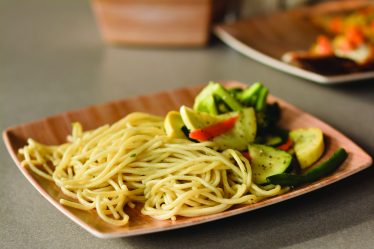By Erasmus Baxter
The first meeting the university’s Food Systems Working Group revealed both the hopes and the tensions underlying the university’s efforts to implement its commitment to sustainable foods.
Last April former president Bruce Shepard signed the Real Food Challenge (RFC), committing to spend 25 percent of the dollars spent on acquiring food for Western’s dining halls on “real food” by 2020. The Food Systems Working Group will create a plan to reach that benchmark.
“[The goal is] not just to getter a higher percentage, or a better metric,” Rosa Rice-Pelepko, co-chair of the working group and a member of Students for Sustainable food, said. “ We really want to be leaders in sustainability.”
However, representatives of Aramark, the company that contracts with Western to provide dining services, expressed concerns about the details of the plan.
“It’s all really basic at a 30,000 foot view,” Patrick Durgan, Aramark’s executive chef on campus, said. “It gets really complicated at the nitty gritty.”
“Real food” is a classification created by the RFC, a nationwide organization working to create a better food system. To qualify as “real food,” food must be local and community-based, fair, ecologically sound and/or humanely produced. Part of the working groups job will be to apply these standards and definitions within the context of Western’s food systems.
Emma Bigongiari is co-president of Students for Sustainable Food and a member of the working group. She points to the differences between the national RFC commitment and the Western specific commitment that Shepard also signed.
“There’s some different standards potentially of what counts as ‘real food’,” Bigongiari said.
One issue the working group will have to deal with relates to the dining hall’s current dairy provider, Edaleen Dairy.
Though Edaleen was originally counted as “real food” because its dairy is locally sourced from Lynden, a recent re-examination found that it should not have qualified because it was a Concentrated Animal Feeding Operation or, factory farm. Being a factory farm is one of the five characteristics that automatically disqualifies food from being considered “real food.”
Stephen Wadsworth, Aramark’s resident district manager, estimates that Edaleen makes up around 7 percent of their purchasing dollars. If it does not qualify as “real food” it would make the benchmark harder to meet.
“It was really easy before Edaleen was disqualified,” Durgan said.
At the meeting Durgan offered a defense of Edaleen, asking whether it was more important to have dairy that was local, or that met RFC standards.
Bigongiari says she’s glad that the issue came up at the meeting.
“[This] first meeting, I feel hopeful,” she said. “I feel like a lot has not been made clear yet and it’ll be interesting to see how things unfold.”
In 2013 Edaleen was fined $17,000 by the state for violating the state’s Water Pollution Control Act, the Farm Journal reported. Polluted water from the farm entered a creek that was identified as a salmon habitat and human recreation area.
In addition, a 2010 report by Western students found that while they thought Edaleen was technically considered “real food,” it should not be considered ecologically sound.
“[Edaleen] cause[s] deterioration of soil from their confined feedlots, and their cows are not free range,” the report read. “The cows consume non-organic corn feed, when by nature they are grass-eaters. Feeding them grain makes them sick, so antibiotics become a necessity in order to keep the cows alive.”
Another issue to consider is how the “real food” percentage is calculated. The RFC has created a calculator to determine the percentage of acquisition dollars spent on “real food”. In Western’s commitment, the 2015 calculator was named as the benchmark for measuring Western’s progress towards 25 percent by 2020. Currently the percentage is calculated monthly by an Aramark student intern.
Wadsworth says that the decision to calculate the percentage monthly was made out out of a commitment to openness. The RFC only requires two audits a year.
“You can greenwash it,” Wadsworth said. “We wanted to be completely transparent.”
To avoid the appearance of a conflict of interest the working group may consider creating a new position outside of Aramark to conduct the calculations.
Since 2008, 40 universities have signed the Real Food Campus Commitment, pledging to spend at least 20 percent of their dining sourcing dollars on “real food” sources. The RFC aims to move $1 billion of university purchasing dollars away from industrial farms by 2020. The minimum commitment is 20 percent by 2020, but some universities have gone as high as 40 percent.
The signing capped years of student activism around the issue. As well as creating and monitoring the implementation of a multi-year plan, the working group will conduct education efforts about the RFC and ensure that a yearly progress report is available online.
Once complete, the working group’s plan and recommendations will be forwarded to Leonard Jones, director of university residences, for final approval.
Kurt Willis, associate director of university residences, co-chairs the working group with Rice-Pelepko.
“[We have] a great journey ahead,” he said.


